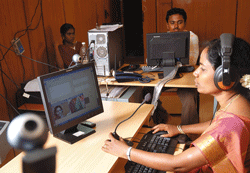 Telemedicine in India is waiting to be expanded on a big scale after certain regulatory and policy steps are taken by the government. It will suddenly explode in terms of size very soon, said Sameer Sawarkar, co-founder & CEO, Neurosynaptic Communications.
Telemedicine in India is waiting to be expanded on a big scale after certain regulatory and policy steps are taken by the government. It will suddenly explode in terms of size very soon, said Sameer Sawarkar, co-founder & CEO, Neurosynaptic Communications.
There has been an unprecedented growth in the Indian healthcare industry with investment from both domestic and foreign investors. The focus is on expanding beds at the private hospitals and infrastructure improvement. However, acute shortage of doctors, has led government to opt for telemedicine as the only way for quality healthcare to reach remote areas. It sees technology adoption to bring equity in access to qualified medical personnel, he said.
Even programmes like Ayushman Bharat and the proposed wellness centres would give a boost to diagnostics and screening with telemedicine.
However there are some regulatory challenges to be overcome to be used in a more widespread manner. For instance dispensing of medicines at the telemedicine centre, especially if the staff at the center are not qualified. Faster, these challenges are overcome, better will it be for the industry and the patients, who are otherwise deprived of quality healthcare, Sawarkar told Pharmabiz.
Telemedicine market in India is US$ 15 million and expected touch US$ 32 million by 2020 according to Assocham. Global telemedicine market expects a CAGR of 16.76% from the current size of estimated US$ 19.36 billion and projected to reach US$ 48.985 billion by 2021. Across the US, telemedicine is the platform for healthcare delivery, insurance to reimburses expenses.
Many companies have various imaging based on artificial intelligence (AI) related diagnostics that would help screening on a large scale. This will in turn help prevent diseases like cancer to reach late stages.
“We see the push for a strong regulatory environment for medical devices and utilisation of CSR for healthcare are expected spur telemedicine. Considerable foreign direct investment for hospital infrastructure along with private equity and venture capital funding for point of care diagnostics B2C telemedicine space have come in.
But the key challenge for those catering to primary healthcare segment is affordability factor. There is also issue to mobilize required human resources to enable remote consultations. This along with connectivity and minimum bandwidth are an issue in several places. Yet another challenge is that the required regulations in product registrations, medical record related norms and import restrictions for pilot projects to projects transition to larger ones need to be ironed out,” said Sawarkar.
Ref: http://www.pharmabiz.com/NewsDetails.aspx?aid=110240&sid=1




